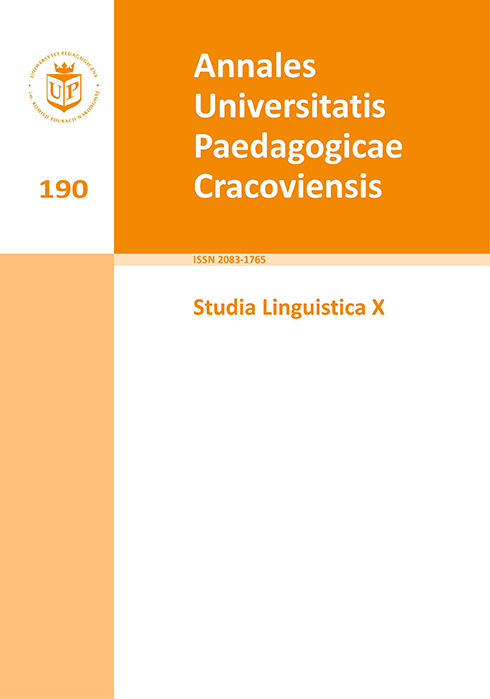Świat roślin w opowiadaniach Ludzie stamtąd Marii Dąbrowskiej
Main Article Content
Abstract
The article presents 89 names which belong to plant lexis. The linguistic material was excerpted from short stories Ludzie stamtąd (People from There) by Maria Dąbrowska. The terminology which is discussed belongs to 10 lexical-semantic areas, namely: 1. Wild and cultivated trees; 2. Wild or cultivated bushes; 3. Wild and cultivated flowers; 4. Herbaceous plants; 5. Lichens; 6. Grasses; 7. Grains; 8. Vegetables; 9. Plant locations; 10. Plant fruits. These names serve a few important functions in the presented works: they take part in the creation of the presented world, they accompany the characters’ moods and emotions, they have a decorative function, and they also play a therapeutic (thus practical) role.
Downloads
Article Details
Author, submitting a text to the editorial board of the journal “Annales Universitatis Paedagogicae Cracoviensis. Studia Linguistica", certifies that the content of the article has not been published so far and that the work does not violate in any way the copyright or related rights of other person, as well as other rights of third parties, and that no one's rights to the work (or any part thereof) have been missed. After signing the contract, the property rights to the published materials are transferred to the Scientific Publisher of the University of the National Education Commission, Krakow.
“Annales Universitatis Paedagogicae Cracoviensis. Studia Linguistica” is an open access journal, and all its content is made available free of charge to users and institutions under the Creative Commons CC-BY-NC-ND 4.0 license (attribution, non-commercial use, no derivative works). Under this license, the authors agree that their work may be lawfully reused for any purpose, except for commercial purposes, without the prior consent of the author or publisher. Everyone can read, download, copy, print, distribute and process these works, provided that the author's marking and the original publication place are correct. Published texts may not be used to create derivative works (e.g. to translate and publish in another language without the consent of the publisher). This is in line with the BOAI (Budapest Open Access Initiative) definition. "Studia Linguistica" does not charge for submitting or processing articles.
References
Bartelski L.M., 1966, Dąbrowska, Warszawa.
Google Scholar
Budziszewska W., 1965, Słowiańskie słownictwo dotyczące przyrody żywej, Wrocław – Warszawa – Kraków.
Google Scholar
Cygan S., 2007, Słownictwo pism Stefana Żeromskiego, t. 9: Świat roślin, Kraków.
Google Scholar
Dąbrowska A., Kamińska-Szmaj I. (red.), 2001, Świat roślin w języku i kulturze, Wrocław.
Google Scholar
Fischer A., 1921, Zwyczaje pogrzebowe ludu polskiego, Lwów.
Google Scholar
Kiljańska I., Mojkowska H., 1988, Zielnik polski, Warszawa.
Google Scholar
Kolankowska L., 2004, Nazwy i funkcje roślin w powieściach chłopskich Elizy Orzeszkowej, „Annales Academiae Paedagogicae Cracoviensis”, nr 19, „Studia Linguistica”, t. II, red. L. Bednarczuk, E. Stachurski, T. Szymański, s. 141‒160.
Google Scholar
Korzeniewska E., 1976, Maria Dąbrowska, Warszawa.
Google Scholar
Korzeniewska E., 1984, Dąbrowska Maria, [w:] Literatura polska. Przewodnik encyklopedyczny, red. C. Hernas, t. 1, Warszawa, s. 179‒180.
Google Scholar
Kuźnicka B., Dziak M., 1977, Zioła i ich stosowanie, Warszawa.
Google Scholar
Maciąg W., 1955, Sztuka pisarska Marii Dąbrowskiej, Kraków.
Google Scholar
Maciąg W., 1972, Wstęp, [w:] M. Dąbrowska, Opowiadania, Wrocław – Warszawa – Kraków – Gdańsk, s. I‒LXII.
Google Scholar
Macků J., Krejča J., 1989, Atlas roślin leczniczych, Warszawa.
Google Scholar
Marczewska M., 2002, Drzewa w języku i kulturze, Kielce.
Google Scholar
Marecki J., Rotter L. (red.), 2007, Symbolika roślin. Heraldyka i symbolika chrześcijańska, Kraków.
Google Scholar
Martuszewska A. (red.), 1997, Literacka symbolika roślin, Gdańsk.
Google Scholar
Ożarowski A., Jaroniewski W., 1989, Rośliny lecznicze i ich praktyczne zastosowanie, Warszawa.
Google Scholar
Pelcowa H., 2001, Nazwy roślin w świadomości językowej ludności wiejskiej, [w:] Świat roślin w języku i kulturze, red. A. Dąbrowska, I. Kamińska-Szmaj, Wrocław, s. 99‒116.
Google Scholar
Rostafiński J., Seidl O. (red.), 1973, Przewodnik do oznaczania roślin, Warszawa.
Google Scholar
Rotter L., 2010, Symbolika kwiatów i ziół, [w:] Symbolika roślin, red. J. Marecki, L. Rotter, Kraków, s. 75‒88.
Google Scholar
Spólnik A., 1994, Funkcja roślin w wybranych utworach E. Orzeszkowej, „Rocznik Naukowo-Dydaktyczny”, z. 168, „Prace Językoznawcze”, t. VIII, s. 239‒243.
Google Scholar
Spólnik A., 1997, Z historii i geografii nazw roślin (na przykładzie Nad Niemnem Elizy Orzeszkowej), „Rocznik Naukowo-Dydaktyczny”, z. 192, „Prace Językoznawcze”, t. IX, s. 239‒259.
Google Scholar
Stoff A., 1997, Problematyka teoretyczna funkcjonowania motywów roślinnych w utworach literackich, [w:] Literacka symbolika roślin, red. A. Martuszewska, Gdańsk, s. 9‒22.
Google Scholar
Troka K., 2011, Ostry smak, ostry zapach i ostre kolce w walce ze złem i chorobą, [w:] Rośliny w języku i kulturze, red. K. Szcześniak, Gdańsk, s. 95‒101.
Google Scholar
Wajda L., 1983, Charakterystyka polskiego słownictwa botanicznego na przykładzie nazw drzew i krzewów, „Rocznik Naukowo-Dydaktyczny”, z. 80, „Prace Języko- znawcze”, t. IV, Kraków, s. 191‒201.
Google Scholar
Wajda-Adamczykowa L., 1989a, Nazwy roślin leczniczych, [w:] Historia leków naturalnych, red. B. Kuźnicka, Warszawa, s. 69‒82.
Google Scholar
Wajda-Adamczykowa L., 1989b, Polskie nazwy drzew, Kraków.
Google Scholar
Wajda-Adamczykowa L., 1992, Rola czynników kulturowych w tworzeniu nazw botanicznych, „Rocznik Naukowo-Dydaktyczny”, z. 152, „Prace Językoznawcze”, t. VII, red. M. Zarębina, s. 235‒252.
Google Scholar

